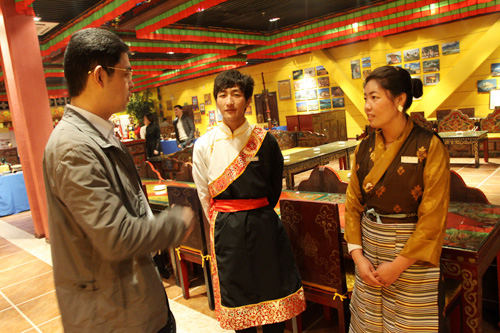|
 |
|
CULTURAL EVENT: The first Han-Tibetan cultural exchange center, named Tibet Impression, debuts in Wuhan, capital of Hubei Province, on November 28, 2010 (SUN XINMING) |
For instance, Tibetan Buddhist religious objects are sold on a business street in Chengdu's Wuhou District. Customers not only include Tibetans living in Chengdu, but also a large number of other Chengdu residents and people from other inland areas. The Yonghe Lama Temple and the High-level Tibetan Buddhism College of China in Beijing and areas around the Wutai Mountain are also major gathering places for Tibetan Buddhist monks and worshipers.
Some Westerners and Tibetans in exile tend to only see the flow of inland people westward into Tibetan-inhabited areas, while ignoring the population flow in the other direction.
Turning a blind eye to the two-way population flow, they constantly claim that the Tibetan language, culture and ethnic characteristics, as well as Tibetan Buddhism, are on the verge of extinction or in danger of being washed away by the so-called one-way flow of Han people into the Tibetan-inhabited areas. The two-way population flow proves these claims to be groundless.
Why do Tibetan people move to hot and humid eastern areas? The migration is driven by China's reform and opening-up policy, urbanization and modernization process and other economic, political, cultural and religious factors.
First, eastward migration from Tibetan-inhabited areas is a historical tradition. Relatively close links between Tibetan-inhabited areas and the central plains were established in as early as the Tang Dynasty (618-907). Enterprising and with strong adaptability, Tibetan migrants have managed to adapt to urban life in inland areas despite differences in weather conditions, social environment and lifestyle. Tibetans who have settled in the plains already, including those working in government and nonprofit organizations, also to some extent encourage and help other Tibetans move east.
Second, Tibetan people are also attracted to inland areas by better work and learning opportunities and higher living standards. In addition, inland metropolitan cities such as Beijing and Chengdu are very inclusive. Tibetans settling in inland areas can travel back and forth between their hometown and resident city, and enjoy the advantages of both places.
Third, the reform and opening-up policy implemented by the Central Government has spurred migration of Tibetan people from their native highlands to the central plains. In the meantime, local governments of regions receiving many Tibetan migrants have also implemented policies favorable to them. For instance, the Chengdu Municipal Government has promulgated policies to support incoming minority ethnic groups to do business.
Fourth, the increased outward flow of Tibetans from their hometown to the country's other regions is a reflection of their desire to identify with other people in the country. This desire has been enhanced by the preferential policies of the Central Government and assistance from other places of the country.
The bi-directional population flows between Tibetan-inhabited areas and other regions in the country have not only promoted exchanges, communication and integration among different ethnic groups but have also helped spread Tibetan culture and religion across the country and even to the outside world.
Meanwhile, the two-way population flow has also helped boost the competitiveness and economic power of Tibetan-inhabited areas and the development of the whole national economy, and promoted harmony between ethnic groups.
The author is a researcher with the Institute of Contemporary Studies under the China Tibetology Research Center
Email us at: yaobin@bjreview.com | 